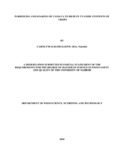| dc.description.abstract | Cassava (Manihot esculenta Crantz) crisps have become an increasingly popular snack in urban Kenya. Processing is however mainly confined informal on the streets, although recently a few small-medium enterprises have been established especially in Nairobi. Recent studies have indicated that the crisps traded in Kenya have cyanide levels exceeding the statutory limits of 10mg/kg. Both boiling and soaking have been found to reduce cyanide levels in cassava though not to the allowed statutory levels. This study therefore was designed to evaluate the physico-chemical characteristics of market cassava crisps, assess the effect of parboiling and retting (soaking) of cassava on the cyanide, oil, and moisture contents of the crisps
For characterization of the physico- chemical characteristics of market cassava crisps, samples were collected from street vendors and supermarkets in Nairobi and Mombasa. These were analyzed for cyanide, moisture, and oil contents. All the samples had cyanide contents exceeding the statutory limits. The oil and moisture contents in majority of the samples exceeding the statutory limits.
For parboiling and soaking studies, samples of fresh cassava roots, not more than 24 hours since harvesting, were collected from three markets in Nairobi namely; Parklands, City Market, and Wakulima Market. These are the main markets where most processors purchase the roots. Each market was sampled three times within intervals of two weeks. The samples were transported transported to the laboratories of the Department of Food Science, Nutrition, and Technology within two hours and stored overnight at 4oC to await processing the next day. For processing, the roots were peeled, washed, and cut into approximately 10cm long pieces. The pieces were then randomized and divided into 7 batches, four for the parboiling and three for the soaking treatments.
xv
For the parboiling treatment, the cassava were boiled while submerged in water for 0, 10, 20, and 30 minutes, followed by rapid cooling in running tap water. The pieces from each treatment were sliced to 1mm thickness and deep-fried in corn oil (Elianto, Bidco oils Ltd, Nairobi) at 1700C until light golden brown in color. For the soaking treatment, the cassava chunks were soaked submerged in water for 0, 1, and 2 days. The cassava were then sliced into 1mm thick crisps and deep-fried the same way as for the boiling experiment. The cassava chunks from both experiments were analyzed for moisture and cyanide. The crisp were analyzed for moisture, oil, and cyanide. The crisps were also subjected to sensory testing shelf life evaluations. Results showed that parboiling alone up to 30 minutes did not reduce cyanide levels to the statutory limit, the cyanide range was 5.40 to 5.94mg/kg. Boiling for 20 and 30 minutes resulted in crisp with cyanide contents below the statutory limits for all samples. At p<0.05, the cyanide contents were significantly different. The moisture and oil contents were within the statutory limits and were not significantly different among the different boiling times at p<0.05. Boiling for 30 minutes yielded significantly the lowest cyanide contents. Boiling for 20 minutes produced the most preferred crisps especially in terms of color and taste. The market effect on parboiled cassava and the crisps characteristics was not significant.
Soaking alone for up to two days was not sufficient to reduce cyanide in cassava chunks to levels within the statutory limits. The chunks soaked for 2 days had an average cyanide content of 17.28mg/kg. The 2-day soaking however, resulted in crisps with cyanide contents below the statutory limits in all samples. The average cyanide content in the crisps was 8.23mg/kg. At p<0.05, the cyanide contents were significantly different among the different soaking durations. The moisture and oil contents remained within the statutory limits and were not significantly different among the different soaking times. Soaking for two days yielded the most acceptable
xvi
crisps in terms of color and taste. The market effect on soaked cassava and the crisps characteristics was not significant.
All the crisps from both parboiling and soaking experiments could be stored at room temperature (approximately 250C) for up to ten months without detectable changes in eating quality.
The study concludes that parboiling cassava for 20 minutes and soaking for 2 days can effect production of acceptable and shelf stable crisps with cyanide contents below the statutory limit of 10mg/kg. The moisture and the oil contents of the crisps also remain within the statutory limits. | en_US |



